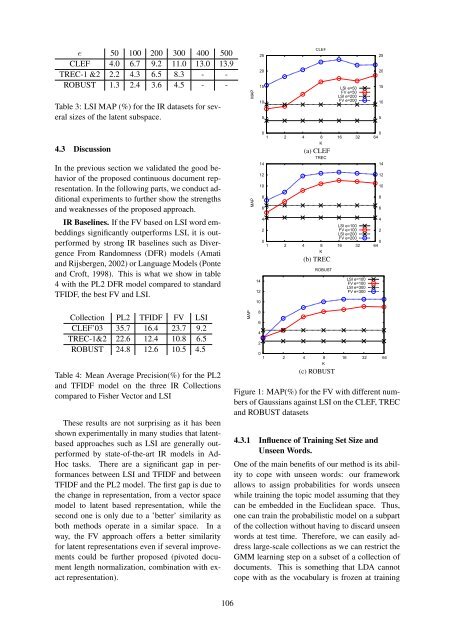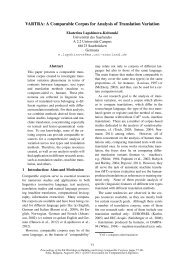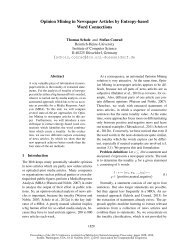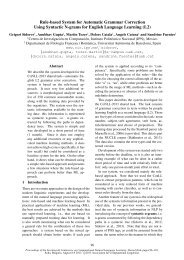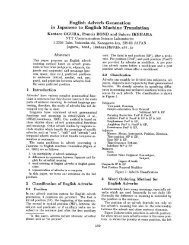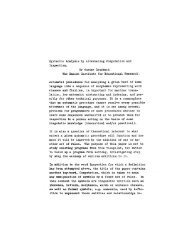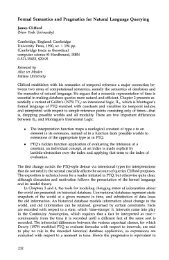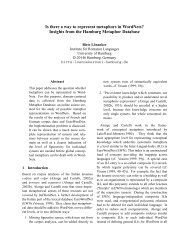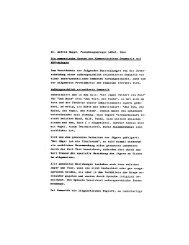Vector Space Semantic Parsing: A Framework for Compositional ...
Vector Space Semantic Parsing: A Framework for Compositional ...
Vector Space Semantic Parsing: A Framework for Compositional ...
You also want an ePaper? Increase the reach of your titles
YUMPU automatically turns print PDFs into web optimized ePapers that Google loves.
e 50 100 200 300 400 500<br />
CLEF 4.0 6.7 9.2 11.0 13.0 13.9<br />
TREC-1 &2 2.2 4.3 6.5 8.3 - -<br />
ROBUST 1.3 2.4 3.6 4.5 - -<br />
Table 3: LSI MAP (%) <strong>for</strong> the IR datasets <strong>for</strong> several<br />
sizes of the latent subspace.<br />
MAP<br />
25<br />
20<br />
15<br />
10<br />
5<br />
CLEF<br />
LSI e=50<br />
FV e=50<br />
LSI e=200<br />
FV e=200<br />
25<br />
20<br />
15<br />
10<br />
5<br />
4.3 Discussion<br />
In the previous section we validated the good behavior<br />
of the proposed continuous document representation.<br />
In the following parts, we conduct additional<br />
experiments to further show the strengths<br />
and weaknesses of the proposed approach.<br />
IR Baselines. If the FV based on LSI word embeddings<br />
significantly outper<strong>for</strong>ms LSI, it is outper<strong>for</strong>med<br />
by strong IR baselines such as Divergence<br />
From Randomness (DFR) models (Amati<br />
and Rijsbergen, 2002) or Language Models (Ponte<br />
and Croft, 1998). This is what we show in table<br />
4 with the PL2 DFR model compared to standard<br />
TFIDF, the best FV and LSI.<br />
Collection PL2 TFIDF FV LSI<br />
CLEF’03 35.7 16.4 23.7 9.2<br />
TREC-1&2 22.6 12.4 10.8 6.5<br />
ROBUST 24.8 12.6 10.5 4.5<br />
Table 4: Mean Average Precision(%) <strong>for</strong> the PL2<br />
and TFIDF model on the three IR Collections<br />
compared to Fisher <strong>Vector</strong> and LSI<br />
These results are not surprising as it has been<br />
shown experimentally in many studies that latentbased<br />
approaches such as LSI are generally outper<strong>for</strong>med<br />
by state-of-the-art IR models in Ad-<br />
Hoc tasks. There are a significant gap in per<strong>for</strong>mances<br />
between LSI and TFIDF and between<br />
TFIDF and the PL2 model. The first gap is due to<br />
the change in representation, from a vector space<br />
model to latent based representation, while the<br />
second one is only due to a ’better’ similarity as<br />
both methods operate in a similar space. In a<br />
way, the FV approach offers a better similarity<br />
<strong>for</strong> latent representations even if several improvements<br />
could be further proposed (pivoted document<br />
length normalization, combination with exact<br />
representation).<br />
MAP<br />
MAP<br />
14<br />
12<br />
10<br />
8<br />
6<br />
4<br />
2<br />
0<br />
14<br />
12<br />
10<br />
8<br />
6<br />
4<br />
0<br />
1 2 4 8 16 32 64<br />
K<br />
(a) CLEF<br />
TREC<br />
LSI e=100<br />
2<br />
FV e=100<br />
2<br />
LSI e=200<br />
FV e=200<br />
0<br />
0<br />
1 2 4 8 16 32 64<br />
K<br />
(b) TREC<br />
ROBUST<br />
0<br />
1 2 4 8 16 32 64<br />
K<br />
(c) ROBUST<br />
LSI e=100<br />
FV e=100<br />
LSI e=300<br />
FV e=300<br />
Figure 1: MAP(%) <strong>for</strong> the FV with different numbers<br />
of Gaussians against LSI on the CLEF, TREC<br />
and ROBUST datasets<br />
4.3.1 Influence of Training Set Size and<br />
Unseen Words.<br />
One of the main benefits of our method is its ability<br />
to cope with unseen words: our framework<br />
allows to assign probabilities <strong>for</strong> words unseen<br />
while training the topic model assuming that they<br />
can be embedded in the Euclidean space. Thus,<br />
one can train the probabilistic model on a subpart<br />
of the collection without having to discard unseen<br />
words at test time. There<strong>for</strong>e, we can easily address<br />
large-scale collections as we can restrict the<br />
GMM learning step on a subset of a collection of<br />
documents. This is something that LDA cannot<br />
cope with as the vocabulary is frozen at training<br />
14<br />
12<br />
10<br />
8<br />
6<br />
4<br />
106


